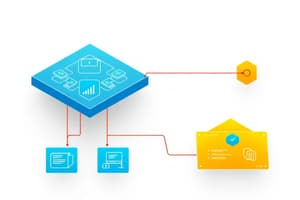Podcast
Questions and Answers
What is the primary purpose of creating wireframes and mockups in user interface design?
What is the primary purpose of creating wireframes and mockups in user interface design?
- To visualize the user interface before development. (correct)
- To model dynamic behaviors within the system.
- To conduct internal peer reviews.
- To document the software requirements specifications.
Which type of documentation is critical during the design review and validation phase?
Which type of documentation is critical during the design review and validation phase?
- Comprehensive design documents. (correct)
- Sequence diagrams of dynamic behaviors.
- Code skeleton and stubs.
- Design patterns used in the software.
What is an essential outcome of stakeholder validation in the design process?
What is an essential outcome of stakeholder validation in the design process?
- To incorporate feedback into the codebase.
- To ensure alignment with software requirements. (correct)
- To specify design patterns used in implementation.
- To conduct peer reviews and walk-throughs.
During preparation for implementation, what does creating code skeletons and stubs primarily help with?
During preparation for implementation, what does creating code skeletons and stubs primarily help with?
What is the focus of continuous design evolution in the software design process?
What is the focus of continuous design evolution in the software design process?
What is the primary benefit of incorporating design patterns in system modeling?
What is the primary benefit of incorporating design patterns in system modeling?
Which of the following is an example of a potential issue identified through verification and validation of design choices?
Which of the following is an example of a potential issue identified through verification and validation of design choices?
How do models improve communication among different teams?
How do models improve communication among different teams?
What should be done after reviewing the Software Requirements Specification (SRS) document?
What should be done after reviewing the Software Requirements Specification (SRS) document?
What does the Detailed Design phase focus on regarding components?
What does the Detailed Design phase focus on regarding components?
Which architectural style allows for the independent deployment of services?
Which architectural style allows for the independent deployment of services?
What is a key purpose of creating architectural diagrams?
What is a key purpose of creating architectural diagrams?
What is crucial to clarify during the requirement analysis and validation phase?
What is crucial to clarify during the requirement analysis and validation phase?
What is the main goal of architectural design in software development?
What is the main goal of architectural design in software development?
Which design approach emphasizes incremental changes and collaboration?
Which design approach emphasizes incremental changes and collaboration?
What does data design primarily involve?
What does data design primarily involve?
What aspect of interface design is particularly emphasized?
What aspect of interface design is particularly emphasized?
Which of the following best describes performance design?
Which of the following best describes performance design?
Big Design Up Front (BDUF) is characteristic of which design approach?
Big Design Up Front (BDUF) is characteristic of which design approach?
What is a key activity in security design?
What is a key activity in security design?
What is a defining feature of Just-In-Time (JIT) design?
What is a defining feature of Just-In-Time (JIT) design?
What primary benefit does modeling provide during the software design process?
What primary benefit does modeling provide during the software design process?
Which of the following diagrams is commonly used to illustrate data relationships in databases?
Which of the following diagrams is commonly used to illustrate data relationships in databases?
How do models serve as a communication tool among team members?
How do models serve as a communication tool among team members?
What does risk mitigation in modeling aim to achieve during the software design phase?
What does risk mitigation in modeling aim to achieve during the software design phase?
Which technique is used to illustrate workflows or processes visually?
Which technique is used to illustrate workflows or processes visually?
During which phase of the software design is modeling considered most crucial?
During which phase of the software design is modeling considered most crucial?
What role do architectural diagrams play in software modeling?
What role do architectural diagrams play in software modeling?
What is one of the key reasons to create early models in software design?
What is one of the key reasons to create early models in software design?
What is the primary purpose of use case diagrams in system design?
What is the primary purpose of use case diagrams in system design?
Which type of diagrams is most effective for analyzing system interactions and communication?
Which type of diagrams is most effective for analyzing system interactions and communication?
How do component and class diagrams contribute to system architecture?
How do component and class diagrams contribute to system architecture?
What can performance and load modeling help predict in system architecture?
What can performance and load modeling help predict in system architecture?
Which modeling language ensures a shared understanding among all stakeholders?
Which modeling language ensures a shared understanding among all stakeholders?
What do architectural patterns and styles help evaluate?
What do architectural patterns and styles help evaluate?
What is the main focus of modeling within software architecture?
What is the main focus of modeling within software architecture?
What does modeling help clarify regarding system requirements?
What does modeling help clarify regarding system requirements?
Flashcards are hidden until you start studying
Study Notes
Key Components in Software Design
- Architectural Design: Establishes the system's high-level structure, defining architecture, layers, and components.
- Component Design: Divides the system into smaller modules, detailing internal structures and functionalities.
- Interface Design: Covers user interaction with the system through layout and navigation, along with how system components communicate via APIs and protocols.
- Data Design: Outlines data storage and access methods, including models, schemas, and data flow strategies.
- Security Design: Addresses security threats with mechanisms for authentication, authorization, and data protection.
- Performance Design: Focuses on efficiency and scalability to manage expected loads, implementing caching and load balancing.
- Design Documentation: Includes detailed blueprints and specifications, utilizing UML diagrams and flowcharts for clarity.
Agile vs. Plan-Driven Design
- Agile Design:
- Evolving through iterative, incremental changes based on newly discovered requirements.
- Implements design "just in time" to adapt to changes efficiently.
- Encourages continuous collaboration among stakeholders for adaptability.
- Plan-Driven Design:
- Follows a Big Design Up Front (BDUF) approach, focusing heavily on initial design before coding.
- Employs a structured sequence in the design process, emphasizing documentation and strict adherence to plans.
Common Modeling Techniques
- UML: Utilizes visual diagrams (class, use case, sequence) to represent system components and behavior.
- Entity-Relationship Diagrams (ERD): Models data relationships for effective database design.
- Flowcharts: Visualize workflows and processes within the system.
- Data Flow Diagrams (DFD): Illustrate how data moves through the system.
- State Diagrams: Depict the states of a system and transitions between them.
Importance of Modeling in Software Design
- Requirement Clarification: Translates complex requirements into visual models for better understanding by stakeholders.
- System Visualization: Offers a visual overview to identify potential issues early in the design process.
- Communication Tool: Serves as a common language among team members and stakeholders to ensure effective communication.
- Risk Mitigation: Early detection of design flaws or ambiguities reduces the risk of costly problems later.
- Guidance for Development: Provides a roadmap for developers to implement features consistently.
- Documentation: Contributes to comprehensive project documentation for future reference and maintenance.
Modeling for Software Architecture
- Visual Representation: Architectural diagrams, like component and deployment diagrams, clarify system structure and interactions.
- Requirements Clarification: Use case modeling helps in understanding functional and non-functional requirements.
- Identifying Key Components: Class diagrams outline the responsibilities and interfaces of system components.
- Analyzing Interactions: Sequence and communication diagrams illustrate data flow and component interactions.
- Evaluating Alternatives: Architectural modeling enables exploration of different patterns and styles for optimal design.
- Scalability and Performance: Models simulate system behavior to inform architectural decisions regarding performance optimization.
- Stakeholder Communication: Standardized notation ensures all stakeholders share a common understanding of architecture.
- Design Patterns: Models incorporate best practices, enhancing code reusability and maintainability.
- Verification and Validation: Detailed models facilitate thorough design reviews, reducing the risk of rework.
- Cross-Functional Understanding: Models are essential for effective communication among diverse project teams.
Flow of Software Design
- Requirement Analysis and Validation: Review the Software Requirements Specification (SRS) for functional and non-functional details, clarifying constraints and ambiguities.
- High-Level Design (HLD): Define system architecture, major components, and their interactions using architectural diagrams.
- Detailed Design (LLD): Specify component structures, interfaces, data designs, and create behavioral models.
- Design Documentation: Compile comprehensive documentation detailing design rationale and patterns used.
- Design Review and Validation: Conduct internal and stakeholder reviews to ensure alignment with requirements and address feedback.
- Preparation for Implementation: Develop initial code structures and plan development tasks, ensuring clear design understanding.
- Design Handoff and Transition: Provide clear design to the development team before transitioning to coding.
- Continuous Design Evolution: Refine designs during development based on new considerations and maintain updated documentation.
Studying That Suits You
Use AI to generate personalized quizzes and flashcards to suit your learning preferences.




